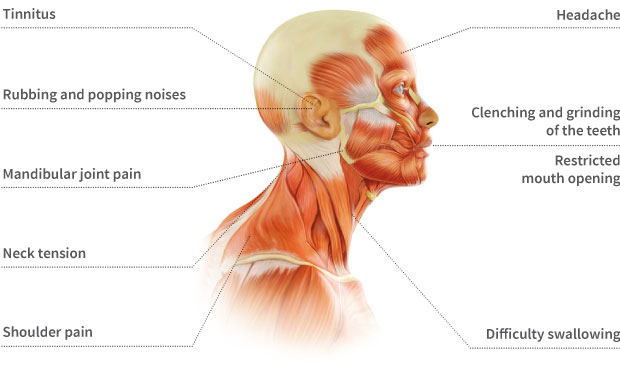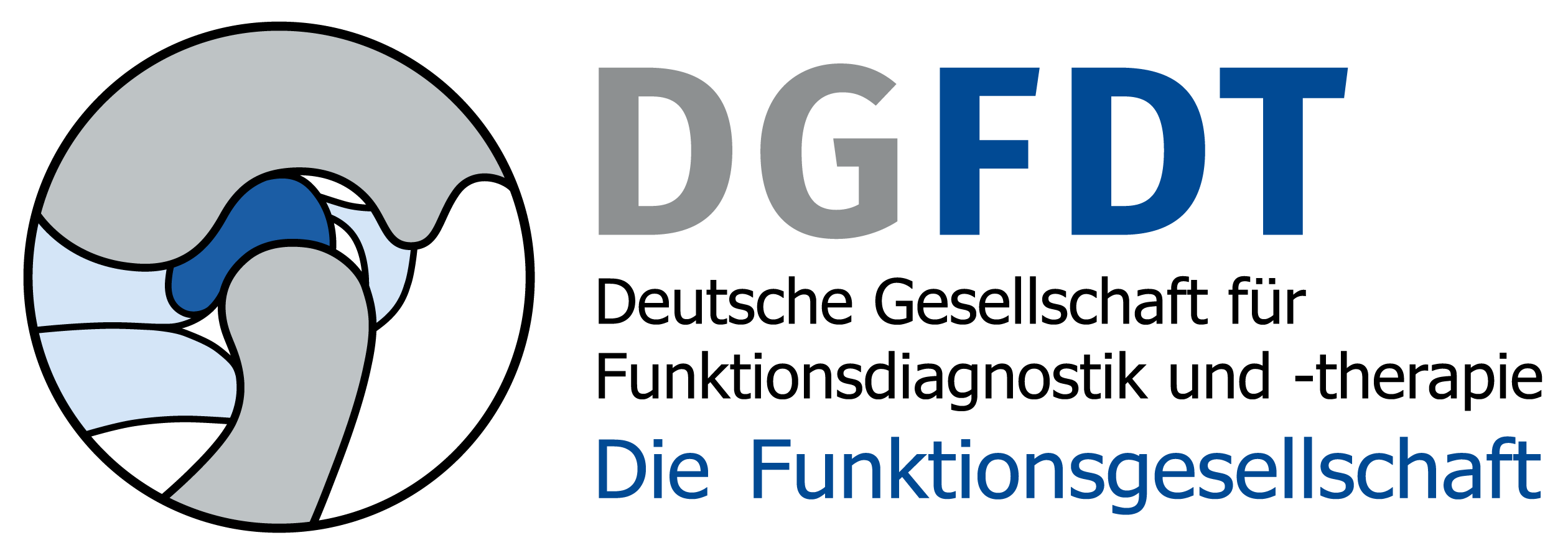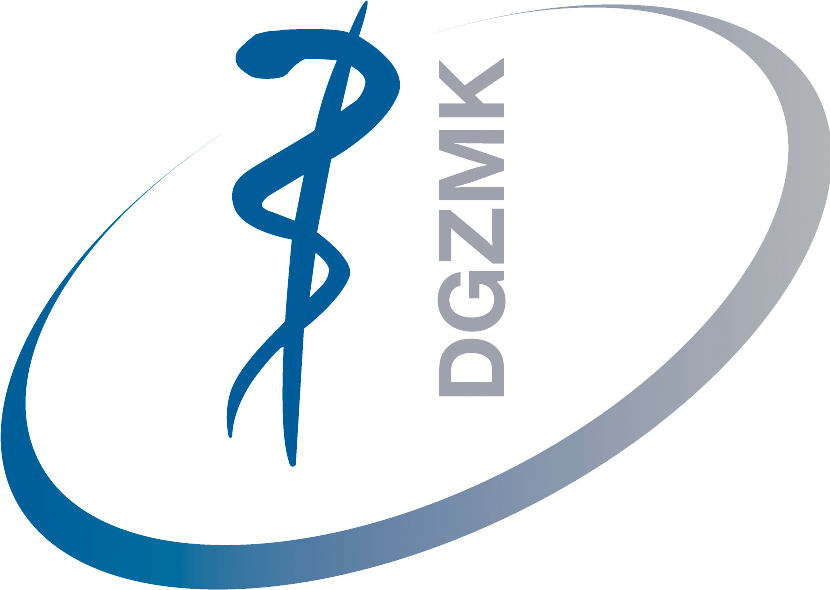
Our services
Craniomandibular dysfunction (CMD)
Possible symptoms include mandibular joint disorders, chronic headaches, neck pain, tinnitus, migraines, dizziness, restricted mouth opening and difficulty swallowing, and even malpositions, such as pelvic obliquity. Symptoms in the mouth include ground down teeth, cervical defects, a sunken masticatory plane, inflammation of the periodontium (periodontitis) and missing supports in the posterior region.
Interdisciplinary therapy is provided, combining splint therapy, grinding therapy, physiotherapy and medicinal therapy.
At our dental practice we only prepare repositioning splints. In order to facilitate therapy of the causes, the neuromuscularly relaxed position of the lower jaw has to be registered.
 You can find more information in German here: Craniomandibular dysfunction (CMD).
You can find more information in German here: Craniomandibular dysfunction (CMD).
Implantology
Dental implants and dentures from a single provider, paying particular attention to masticatory correlations, are the cornerstone of our dental surgery.
Dental implants are becoming more and more a standard service of modern dentistry. As the basis of a prosthetically sophisticated procedure, they represent a reliable alternative to periodontally or endodontally pretreated abutment teeth. This way, supports which are no longer in place, can be restored. I took the two-year postgraduate course and obtained the “Master of Science in Oral Implantology” at the Deutsche Gesellschaft für Implantologie (DGI) in order to consolidate and further develop my more than a decade of experience as dentist active in implantology.
You can find more information in German here: Zahnimplantate.
Dentures
The preparation of high-grade dental prostheses is a central component of our practice concept. We work together with the Rübeling+Klar dental laboratory, in the direct vicinity of our practice, to produce metal-free ceramic inlays, partial crowns, crowns and bridges, using CAD/CAM technology and removable-fixed bridges and partial prostheses on spark-eroded telescopes which facilitate a perfect and durable fit.
You can find more information in German here: Zahnersatz.
Aesthetic medicine
We use modern methods of aesthetic dentistry to maintain and form your healthy smile.
These include tooth bleaching, tooth-coloured filling techniques, e.g. composite fillings or CAD/CAM-produced ceramic inlays, veneers, fully ceramic partial crowns and bridges and orthodontic corrections of malpositioned teeth in adulthood, using the almost invisible IN-LINE method.
You can find more information in German here: Ästhetische Zahnheilkunde.
Periodontology
Periodontium disorders are the main reason for the loss of teeth in adult patients. The syndrome – often trivialised by the patient with the argument “But it doesn’t hurt” – is an infectious disease with acute and chronic phases. The bacteria which destroy the periodontal apparatus irreversibly, also afflict the immune system and the complete human organism. The transfer of the bacteria via the bloodstream can compromise the heart, liver and kidneys.
The systematic treatment of existing periodontitis is an imperative prerequisite for all further-going treatments, such as implantation and dentures. Regular professional dental cleaning sessions are vital for the success of therapy for periodontitis.
You can find more information in German here: Parodontologie.
Tinnitus therapy
Tinnitus aurium describes what are usually subjectively perceived noises which are not generated by sound externally. Innumerable emergences of “ringing in the ears” are described. Up to 20% of the population suffer from tinnitus; on one side or on both sides, temporary or permanent, with a changing or constant frequency and amplitude. Up to three months after the first occurrence, it is classified as acute, subsequently as chronic with severely decreasing chances of a cure. Tinnitus is often a symptom of craniomandibular dysfunction (CMD). Before a functional therapeutic intervention by the dentist, the patient should always be referred to an ear, nose and throat specialist for clarification. Two thirds of all tinnitus patients have at least two symptoms of CMD. 67% of CMD patients are diagnosed with tinnitus.
The therapy for masticatory tinnitus comprises the establishing and long-term stabilisation of a neuromuscularly relaxed lower jaw position using splint therapy, grinding therapy or prosthetic construction of the masticatory plane.
You can find more information in German here: Tinnitustherapie.
General dental medicine
Our practice provides you with “conventional” dentistry services. These include regular six-monthly check-ups, treatment for caries, filling therapy, pain relief and root canal treatments.
You can find more information in German here: Allgemeine Zahnheilkunde.
Endodontics
The pulp of the tooth (nerve, blood vessels and connective tissue) can become inflamed as a result of caries or fractures, for instance. Bacteria settle on the tooth and infect the bone through the pulp.
These days, modern techniques and materials allow us to maintain our teeth for longer. In the past, the treatment of complicated roots and jaw infections originating from the tooth often used to lead to the loss of teeth.
You can find more information in German here: Endodontie.
Sleep apnoea
When we talk about sleep apnoea, in most cases we mean what is referred to as obstructive sleep apnoea syndrome (OSAS). It is the most common cause of a sleep-related respiratory disorder. The collapse of the pharyngeal muscles causes an obstruction (narrowing / closure) in the upper airways during sleep.
It is important to differentiate between OSAS and a central apnoea with its completely different cause. In the event of a central apnoea different processes in the body lead to respiratory arrest. The following text deals with obstructive sleep apnoea (OSAS) syndrome only.
It causes a temporary respiratory arrest and insufficient ventilation of the lungs. This results in an increasing carbon dioxide content in the blood and, in turn, a waking response in the affected party (micro arousal). The decreasing hypoxaemia (oxygen saturation) triggered at the same time leads to an insufficient oxygen supply in the tissue of the body and the brain.
In most cases the arousal does not cause the affected party to awaken consciously. Merely the bodily function, such as the pulse and the release of stress hormones, increase. The sequence of sleep phases also changes, the recovery and regeneration functions of the night’s sleep being considerably reduced.
The consequences of obstructive sleep apnoea syndrome (OSAS) are wide-ranging and can make for a high health risk, for instance:
- Daytime fatigue with microsleeping
- Cardiovascular disorders, such as cardiac arrest, apoplexy, high blood pressure, cardiac failure with an impact on life expectancy
- Dizziness when getting up in the morning
- Headaches and / or oral dryness when waking up
- Urination during the night, more frequent urgency to urinate during sleep (nocturia)
- Night sweats
- Concentration problems and even memory disorders
- Depressive malaise
- Erectile dysfunction, impotence
- Restless sleep
- There is a suspected connection to disorders, such as tinnitus, hearing loss, stomach ulcers, type-2 diabetes mellitus
The first means of therapy for OSAS is a “continuous positive airway pressure” machine (CPAP device). A nasal mask or a full-face mask is connected to the bellows of the CPAP machine by a hose. This generates negative pressure in the upper airway, keeping it open and preventing an obstruction.
In many cases the affected party is unable to sleep with this type of mask. A mandibular advancement splint for the lower jaw can then be used to hold open the airway in a simple manner.
The lower jaw is shifted forwards by a matter of millimetres, thus preventing the collapse of the pharyngeal muscles. The airway remains free. This way, many patients are able to avoid having to sleep with the cumbersome mask of the CPAP machine. The affected parties sleep through peacefully and comfortably and the mandibular advancement splint saves them from the serious health consequences of sleep apnoea in the most simple manner.
Advantages and disadvantages of a mandibular advancement splint for therapy of obstructive sleep apnoea:
Advantages:
- Prevents snoring
- Small and compact and can be inserted almost invisibly, even when travelling
- Does not restrict sleeping on one’s side
- The splint can be inserted and removed easily
- Individual customisation prevents an overload of the jaw joint and the teeth
Disadvantage:
- The functionality of self-adjusted snoring splint sets is limited and there is a risk of overloading the teeth
Please note that primarily patients with a minor to moderate sleep apnoea can benefit from this type of splint. In case of a very pronounced sleep apnoea other therapy concepts may be necessary.
Contact us and we will be happy to provide you with individual consultation and answer all your questions on the matter.
The respective specialist associations also provide information on this subject:
Deutsche Gesellschaft für Schlafforschung und Schlafmedizin (German Sleep Society): www.dgsm.de
Deutsche Gesellschaft zahnärztliche Schlafmedizin (German Society for Dental Sleep Medicine): www.dgzs.de
You can find more information in German here: Schlafapnoe.
Snorer's splint
Snoring can often be completely prevented by opening the airway with a mandibular advancement splint which moves the lower jaw slightly forwards. The flapping of the velum (uvula) and the snoring noise which this causes are prevented as the splint generates tension in the muscular structures in the pharynx area and reduces the resistance in the airway.
You can find more information in German here: Schnarchschiene.
Individual prophylaxis and professional dental cleaning
Our specially trained Dental Hygienists carry out professional dental cleaning to remove hard and soft deposits gently. Plaque which is not removed – in particular between teeth and implants, where patients have difficulty carrying out perfect cleaning – leads to inflammation of the gums. The eradication of unpleasant discolouration is a pleasant side effect. Polishing and fluoridation have a lasting protective effect. Individual consultation and motivation for our patients is also an important part of the treatment.
Professional dental cleaning is an important maintenance therapy after periodontitis therapy has been carried out. Without it and without optimised oral hygiene by the patient, stabilisation and long-term healing of chronic periodontitis is not possible.
Regular cleaning and the cooperation of the patient are also important for a stable implant result. Lingering plaque deposits on implants can lead to inflammation of the gums and subsequent osseous implant loss, peri-implantitis, similar to periodontitis on the tooth.
You can find more information in German here: Professionelle Zahnreinigung.
Our Surgery hours
| Monday | 08.00am - 12.00pm 01.00pm - 04.00pm |
| Tuesday | 01.00pm - 07.30pm |
| Wednesday | 10.00am - 02.00pm |
| Thursday | 01.00pm - 07.30pm |
| Friday | 08:00am - 02.00pm |
Contact
Marzahner Chaussee 88
12681 Berlin




